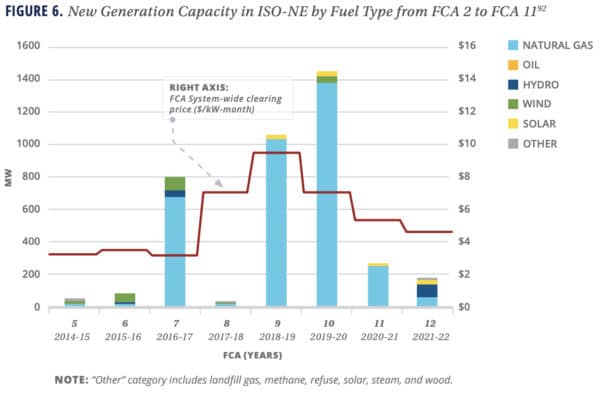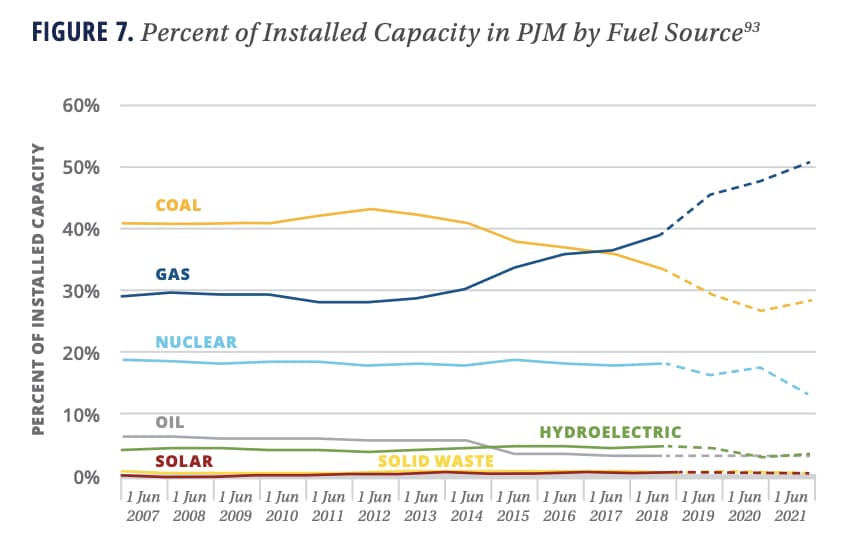Politicians are taking a stand for state-level renewable mandates, aiming to change the capacity markets that favor fossil generation in several grid regions. Those capacity markets are biased against renewables and storage, and are costly, while resource adequacy goals can be better met through other means—according to a new report.
Eight U.S. Senators have challenged the capacity market in New England’s ISO-NE grid as it “forces renewable energy to wait for incumbent fossil fuel generators to retire before these clean energy resources can enter the capacity market.” And 11 state attorneys general have called on the Federal Energy Regulatory Commission (FERC) to work with them to “assist markets in maintaining resource adequacy at just and reasonable rates.”
Right on cue is a richly detailed 24-page report on the capacity market problem, prepared by Grid Strategies and commissioned by the Sustainable FERC Project. That report highlights two key problems: cost, and bias against renewables.
Driving excess capacity, and costs
The three grid operators with mandatory capacity markets “have much more generating capacity than typical reserve margins,” with the excess capacity costing about $1.4 billion per year, says the report. The three grid regions—PJM, NYISO, and ISO-NE—cover the northeast quadrant of the continental U.S.
In those regions the levels of reserve capacity are extraordinary, reaching over 35% in PJM. And consider that some electricity consumers would be happy to cut their consumption at peak hours for less than $1,000 per kWh in New York’s NYISO region, or $200 per kWh in New England’s ISO-NE region—the “value of lost load” implied by the reserve requirement in those capacity markets, according to the report.
The PJM, NY-ISO and ISO-NE grid regions experience annual peak consumption in the summer. Yet in all three regions, “all capacity resources must perform all year,” says the report. In other words, the capacity markets are rigged to exclude solar and storage, even though solar production is greatest when capacity is needed most.
Although solar and storage are now cost-competitive with new gas generation, the $1.4 billion per year for excess fossil capacity has helped fuel a bonanza for gas unit construction. Gas-fired generating capacity has increased by 11 GW in the PJM region in the past two years, and 34 more GW are planned, as reported by Bloomberg. The image above from the Grid Strategies report illustrates that dynamic.
And a similar story holds for New England; here’s a graph showing recent and planned gas capacity additions (in light blue) in ISO-NE:

Bias against renewables
Many of the utilities that control regional grid operators favor fossil generation, and some own extensive natural gas assets. So it’s no surprise that capacity markets have inherent biases against renewables and storage. Some notable comments from the report:
- Sellers of capacity (e.g., owners of gas units) already have revenue from capacity markets, so they can afford to earn less in wholesale energy markets. That “tends to reduce prices in the wholesale energy markets on which renewable sources depend.”
- “Energy-only markets with scarcity pricing would be better for renewables.” In regions without capacity markets, such as the ERCOT region in Texas, costs for providing extra capacity “are typically recovered from the energy market when, during a small number of hours per year when energy supply is scarce, energy market prices increase to very high levels.”
- “Capacity planning has failed to account for storage capacity value” due to requirements such as “arbitrary duration rules … for 4 to 10 hours.”
The report references an op-ed from former Maryland Governor Martin O’Malley, likening the regional grid operators that design capacity markets to cartels:
These regional entities — which were supposed to serve a reliability function and handle voluntary exchanges of power — have now somehow decided to insert themselves in states’ business. They operate like a cartel, with suppliers on committees voting on rules.”
The report’s concluding section proposes better alternatives to the current capacity markets, to meet legitimate grid needs. The Sustainable FERC Project plans to share the report “with grid operators, state regulators and federal officials to help encourage reform of these outdated capacity market rules,” said Tom Rutigliano, senior advocate with the project.
The Grid Strategies report, titled Too much of the wrong thing: the need for capacity market replacement or reform, was written by Rob Gramlich and Michael Goggin. The Sustainable FERC Project, which commissioned the report, is a partnership among 24 citizens’ groups.
This content is protected by copyright and may not be reused. If you want to cooperate with us and would like to reuse some of our content, please contact: editors@pv-magazine.com.








There are too many “pressure points” on fueled generation, the major problem has always been “commodity fuels” can be volatile and uncertain in price or availability. Solar PV and wind generation are understood to be “intermittent”, as such, energy storage is a viable answer for keeping the grid stable and robust no matter what generation resource is online.
The less fueled generation, more energy storage construction is just becoming the direction taken by some larger energy companies. It needs to be adopted by smaller local utilities and co-ops to strengthen the grid from end to end.